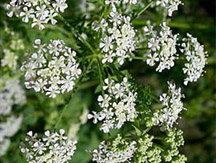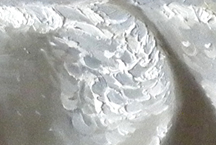
One of the most important events that took place at the very end of the 5th century BCE was the death of Socrates. I wanted to incorporate this into the composition of the painting without actually painting the flowers. The white flowering plant above is the blossom of the hemlock which I replicated across the surface of the focal piece of white cloth, shown at top.
Socrates was convicted of two ambiguous charges: corrupting the youth and impiety. He was forced to drink the hemlock liquid, and died in 399BCE. A new book about these events has just been published, The Hemlock Cup by Bettany Hughes.
To achieve the actual look of the flower on the cloth, a mid-value white was applied, using white+yellow ochre+black. Then a lighter quite sticky mixture was applied in the shape of the circular petals. One of my favorite mediums is the Venetian Medium. Paint it onto a dry surface and couch the upper layer into this for a wet on wet technique. By mixing a few drops of a more liquid medium such as the Strasbourg medium right into the paint, it forms a nice sticky workability. This maybe sounds counter-productive, but it works well for this application.


Julius Nellis
Great, thanks for sharing this post. Fantastic.